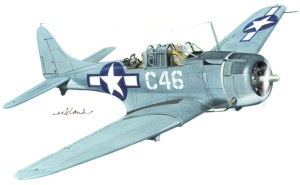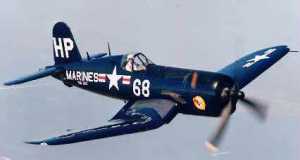 In 1941, the Marine Corps commissioned two air wings. By the time of Japan’s attack at Pearl Harbor, the Marine Corps had deployed roughly half of its air squadrons to the Pacific. Marine aviation assets were found at Ewa Field, Hawaii, and with the garrison at Wake Island. They were flying the Grumman F4F Wildcats. When the Japanese attacked on 7 December 1941, they were not as surprised as they were overwhelmed. Desperate months followed, and for much of this time, the Marines were out-numbered and out-gunned. With the amphibious assault on Guadalcanal, the Navy-Marine Corps team had begun their first offensive campaign. Within seven days, combat engineers made the captured air strip at Guadalcanal suitable for landing American aircraft and this began with Captain John Smith’s VMF-223, flying F4F Wildcats, and Major Richard Mangrum’s VMSB-232, flying the Douglas SBD-3s. They were followed by Vought F4U Corsairs and a veteran by the name of Roy S. Geiger, the Marine Corps’ fifth naval aviator, commanding the 1st Marine Aircraft Wing. These Marines had little opportunity for aviation missions in direct support of ground forces, however. As long as the Battle for the Solomons was uncertain, Marine aviators were employed to interdict Japanese air raids and reinforce convoys operating adjacent to Rabaul.
In 1941, the Marine Corps commissioned two air wings. By the time of Japan’s attack at Pearl Harbor, the Marine Corps had deployed roughly half of its air squadrons to the Pacific. Marine aviation assets were found at Ewa Field, Hawaii, and with the garrison at Wake Island. They were flying the Grumman F4F Wildcats. When the Japanese attacked on 7 December 1941, they were not as surprised as they were overwhelmed. Desperate months followed, and for much of this time, the Marines were out-numbered and out-gunned. With the amphibious assault on Guadalcanal, the Navy-Marine Corps team had begun their first offensive campaign. Within seven days, combat engineers made the captured air strip at Guadalcanal suitable for landing American aircraft and this began with Captain John Smith’s VMF-223, flying F4F Wildcats, and Major Richard Mangrum’s VMSB-232, flying the Douglas SBD-3s. They were followed by Vought F4U Corsairs and a veteran by the name of Roy S. Geiger, the Marine Corps’ fifth naval aviator, commanding the 1st Marine Aircraft Wing. These Marines had little opportunity for aviation missions in direct support of ground forces, however. As long as the Battle for the Solomons was uncertain, Marine aviators were employed to interdict Japanese air raids and reinforce convoys operating adjacent to Rabaul.
 During the twenty months following Guadalcanal, the Marines rarely fought as an air-ground team. Then in November 1943, a new front opened in the Central Pacific, which committed most Marine ground forces to a series of island operations through the end of the War. The vast distances between island objectives and the paucity of airfields made it next to impossible for aviation Marines to support their brothers on the ground. Aircraft carriers might have been the solution to this problem, but the Navy was unwilling to replace its own air groups with Marines. This problem continued until November 1944, when Admiral Chester W. Nimitz agreed to accept Marine Corps air support squadrons on board escort carriers in future amphibious operations. It took time to implement these new programs; Marine ground forces did not fully benefit from carrier-based Marine air cover until the Battle of Okinawa in April 1945.
During the twenty months following Guadalcanal, the Marines rarely fought as an air-ground team. Then in November 1943, a new front opened in the Central Pacific, which committed most Marine ground forces to a series of island operations through the end of the War. The vast distances between island objectives and the paucity of airfields made it next to impossible for aviation Marines to support their brothers on the ground. Aircraft carriers might have been the solution to this problem, but the Navy was unwilling to replace its own air groups with Marines. This problem continued until November 1944, when Admiral Chester W. Nimitz agreed to accept Marine Corps air support squadrons on board escort carriers in future amphibious operations. It took time to implement these new programs; Marine ground forces did not fully benefit from carrier-based Marine air cover until the Battle of Okinawa in April 1945.
 General Geiger was the first Marine Corps aviator to command a joint-service amphibious corps. He waged an effective and highly successful campaign at Bougainville, Guam, Peleliu, and Okinawa. As an aviator, he was always seeking a way to employ Marine Corps air assets in support of ground troops. It finally did come together at Peleliu. The first significant close air support mission was executed by Major Robert Stout’s VMA-114, supporting a battalion sized assault on Ngesbus Island. Twenty Corsairs strafed the beach defenses a mere 30 feet off the water, barely ahead of landing craft. The aircraft enabled the Marines to overwhelm a much larger force and capture the island.
General Geiger was the first Marine Corps aviator to command a joint-service amphibious corps. He waged an effective and highly successful campaign at Bougainville, Guam, Peleliu, and Okinawa. As an aviator, he was always seeking a way to employ Marine Corps air assets in support of ground troops. It finally did come together at Peleliu. The first significant close air support mission was executed by Major Robert Stout’s VMA-114, supporting a battalion sized assault on Ngesbus Island. Twenty Corsairs strafed the beach defenses a mere 30 feet off the water, barely ahead of landing craft. The aircraft enabled the Marines to overwhelm a much larger force and capture the island.
Corsairs provided close air support to protect badly mauled Marine battalions near Bloody Nose Ridge on Peleliu; they brought with them terrifying new weapons: napalm and high explosive rockets. Such destructive weapons used in close air support missions demanded very close air-ground coordination. The Marines implemented a process of air liaison parties (ALPs), which were primarily Marine pilots with radio operators to accompany infantry commanders, much in the same way as artillery forward observers. Landing Force aviation control units began to coordinate ALPs during the battles for Iwo Jima and Okinawa.
In mid-1944, Marine squadrons were languishing in the Central Pacific, relegated to dropping bombs on bypassed Japanese island garrisons. With MacArthur’s return to the Philippines, however, elements of the 1st Marine Aircraft Wing flew in support of operations in Leyte. The Philippine battles were far different from those of small coral atolls and the Marines participated in a wide range of operations, from close air support and air interdiction to attacks on Japanese shipping. The Battle for Okinawa was the largest air-ground battle of the Pacific War.
To be continued

I’m sorry, this is totally off-topic and I feel bad that I’m the first commenter, as I don’t want to detract from this series. But I have to say thank you for the excellent post in October on The Village which I just finished reading. That thread is closed, and I didn’t know where else to comment. It was such an alteration in perspective and the topic of our conversation here for over a week. An amazingly worthy read.
LikeLike
A remarkable history indeed, sir. We can see the development was achingly slow for our Marines. They were faced with 3rd down and long… but as per Shoup’s famous report, “…we are winning”. Geiger was brilliant, even off the battlefield. The use of the Corsairs over the Philippines was a valuable tidbit as well. A question about the F4F’s and Midway. Were some of these ferried by Halsey in the few days before Pearl to account for the carriers not being there? And wasn’t there a compliment of the obsolete Buffaloes as well?
LikeLike
Although the Buffalo was one of the first monoplanes suitable for carrier service and won out in competition with the Wildcat in 1939 to become the Navy’s first single wing fighter, Marine pilots regarded the Buffalo as a flying coffin. The weight to power ratio resulted in less agility and power during air-air engagements.
LikeLike